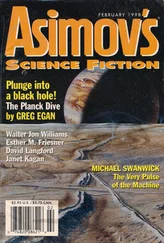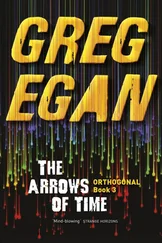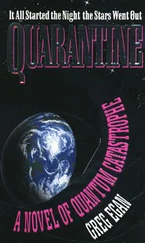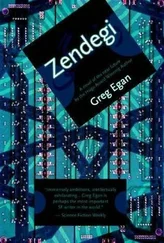"All right."
In a spare corner of Parantham's mind, a sketch of the virtual creature took shape. While Rakesh watched the adult below him scurrying along, pausing now and then to graze on patches of fungus, a second viewpoint showed him an annotated diagram of the developing embryo in its egg case. As morphogen gradients washed over the dividing cells, eight distinct segments formed, the middle six slowly sprouting a tightly folded pair of legs each. Mouthparts, excretory and reproductive organs were whittled out of the growing mass of cells. The developing nervous system was extremely simple, and by the time the egg hatched it was close to hardwired: a handful of innate drives and reflexes would enable this creature to move, feed and mate, but it had no potential to do anything more complex.
Like all DNA-based life it was Rakesh's distant cousin, but it was unlikely to be a direct descendant of whoever had built this ark.
"It doesn't use infrared at all," Parantham observed. "It listens for sounds conducted through the tunnel wall."
"So how did it home in on me when I was standing stock still?" Rakesh examined the model's results more closely. "Aha. Resonances set up by its own footsteps. A kind of sonar, after all." It was impossible to say exactly how this creature's natural ancestors had lived, but the engineered traits it possessed were extensive and ingenious. The Arkmakers might not have had the technology to locate, let alone reach, another planet like their own, but they had worked hard to adapt life to their new environment.
"So where are its designers?" he asked Parantham.
"Be patient," she replied. "We've barely scratched the surface."
When they reached a fork in the tunnel, they launched a small probe to keep following the twelve-legged creature, and they took the other turn, in toward the center of the ark.
Rakesh kept waiting for a riot of new lifeforms to appear before his eyes — to cross some threshold that marked the end of the barren outskirts, and witness a sudden explosion of diversity — but all they saw were the same kinds of fungus and the same spider-like creatures eating it. In fact, the further they went the sparser the fungus became.
"The stellar wind powers the whole ecosystem," Parantham mused. "But it barely penetrates this deep. Parts of the walls are permeable to it, parts are not; it's as if they designed the ark to have a certain flow, a certain set of currents running through it. But the wind must have been much stronger then. These days, it's too feeble to do the job. And there doesn't seem to be any other mechanism for transporting energy in toward the center."
Rakesh didn't reply, but he couldn't help following her argument to its logical conclusion. The Arkmakers had invented a whole new ecosystem to live in after the death of their planet, but the vagaries of the bulge had defeated them yet again. They had relied on the hot winds from nearby giant stars as their new primary energy source, turning their backs on the relatively weak radiation from their small but stable foster-sun. Giant stars had short lives, and while new ones were always being born, in any particular place the stellar wind could ebb and flow dramatically on a time scale of just a few million years. The Interloper might have finished off the Steelmakers, but it could have provided whoever came after them with more or less constant light for another three billion years.
As they flew deeper into the ark, the fungus disappeared completely. The interior was barren. With nothing to repair them, the walls became increasingly cracked; small thermal stresses over the millennia had torn at the structure, in places reducing it to loose piles of rubble. Electromagnetic probes revealed what might once have been a network of copper wires running through the walls — distributing power, perhaps, or information — but they were just fragmented segments now, worn and snapped by minuscule but relentlessly patient forces.
About halfway to the center, rubble blocked their way. They despatched a swarm of small probes that could squeeze into the interstices, then backtracked and took a turn sideways, to see if there was anything that they could explore "for themselves". Rakesh had grown used to his new body, and he was reluctant to give it up and return his senses to Lahl's Promise .
He said, "Fifty million years is a long time to expect anyone to stay cooped up in a place like this. Maybe the Arkmakers finally developed interstellar travel, mined the asteroids for some raw materials, and then headed right out of the NSD to search for a safer home."
"That's possible," Parantham replied. "And if we can't see the hole where they burrowed out of this cocoon, maybe the fungus sealed it off." She hesitated. "The design still doesn't make a lot of sense to me, though. Even if the stellar winds were much stronger when this place was built, I can't see what the flow was optimized for . There's a very precise gradation in the density of the wall material; it's far too regular to be accidental, so it's either an engineering feature that I just don't understand, or a reflection of a very weird esthetic. If you chop this place in half along the center of the long axis, there's more flow-through in one half than the other. What's that all about? And I'd swear the local variations are designed to induce turbulence that would scatter the fungus as widely as possible, but the fluid dynamics is all wrong for any plausible stellar wind that might have blown into this system."
The way ahead was blocked by a cloud of rubble again. Rakesh braked and let himself float in the middle of the tunnel.
He said, "This thing has no engine. How do you think they got it clear of the planet when the neutron star came through?"
Parantham shrugged. "They might have taken it up in small pieces, and used the fungus to weld them together."
"That's assuming they had rockets at all," Rakesh said.
"Well, yes. If they didn't, they could have simply built it on the ground and let the tidal force lift it. That would have been a very risky strategy, though."
"Where would the safest launching site be?" Rakesh glanced at a model and answered his own question, "The point furthest from the neutron star at the moment when its tidal force canceled the planet's gravity. Assuming that it survived the quakes, the ark would simply drift up into space."
Parantham said, "It wouldn't have had much of a head start, though, before all the rocks came tumbling after it. Collisions between the debris would redistribute its momentum, creating some fragments that would outrace the pack. You couldn't avoid a serious peppering, at the very least."
"I suppose they could have made more than one ark, to improve the odds," Rakesh suggested. "The others might have been destroyed by debris, or captured by the neutron star."
Parantham let out a long, reproachful moan. "Captured by the neutron star?"
Rakesh was bemused. "You don't think that's possible?"
"Of course it's possible. And that's exactly what they wanted! This one's the failure, the one that was left behind!"
"How is it a failure to get left behind?"
"The giants' stellar wind," she said, "has a greater energy density than middle-aged starlight, but there's something that would give it even more oomph: the gravitational field of a neutron star. The neutron star would have drawn the wind into an accretion disk around it, far richer in energy than anything else in sight. The Arkmakers saw this monster coming, and thought: if it's going to pulverize our home, better to learn to drink from that whirlpool than skulk around in the ruins waiting for the next disaster.
"This ark, and everything in it, was designed to survive in an accretion disk. The asymmetrical flow-through would have given it a kind of buoyancy, pushing it back out into larger orbits if it ever sank in too deep." Parantham ran a model, and piped the output to Rakesh. "The wind in the disk would have been strong enough to keep the fungus alive almost everywhere, to support the food chain throughout the ark."
Читать дальше











